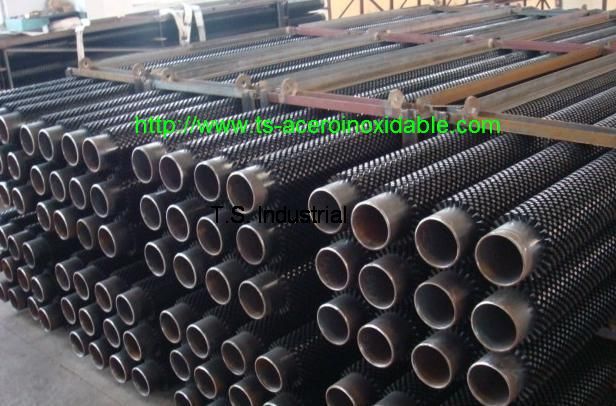


Studded Tube or called Nailhead tube
|
Base Tube O.D |
Base Tube Thickness (mm) |
Fin Height |
|
|
38 mm ~219 mm |
4.0 mm ~20 mm |
6.0 mm ~ 38 mm |
|
|
Base Tube Material |
Fin Material |
Tube Length (Mtr) |
|
|
Carbon Steel ,Alloy Steel ,Stainless Steel |
Carbon Steel ,Alloy Steel , |
≤ 15Mtrs |
|
Steel studded tubes are used instead of finned tubes for heat transfer in the processing industries, generally in furnaces, gas turbines, fired heaters and furnace applictions where the surface is exposed to a very corrosive environment and where very dirty gas streams require frequent or aggressive cleaning.
The steel studs are automatically resistance welded to the tube, producing high quality forge welds. The welding process enables the combination of any grades for studs and tube: carbon, low alloy, stainless steels and high nickel alloys. Alloy steel pipes are stress-relieved after studding, according to the relevant specifications for the class and grade of steel used.
Because of their relative easy of cleaning, studded tubes or nail head pipes are used in furnaces and fired heaters as an alternative to high frequency welded finned tubes wherever the process application is such that heavy fouling of the external surface may occur.
The studs are attached to the pipe in diametrically opposing pairs around the circumference by electrical resistance welding to ensure a high integrity bond for strength and heat flow. Stud diameter, height and pitch can be specified on an individual basis.
Welding tests are carried out as a matter of course to ensure the effectiveness of the stud to pipe bond. Heat treatment of the completed studded tube is carried out where necessary. Should fouling eventually reduce the process performance of the equipment, the studded surface can be cleaned efficiently by shot blasting without damage to the materials.
An electric current is applied by connect on the stud and tube and theresistance in this circuit produces the heat necessary for welding. Maximum resistance and therefore maximum heating occurs at the interface between the Stud and the tube. Pressure to forge the Stud and the tube together at the point of maximum heating is applied by various forms of tooling. These resistance welding processes produce a strong metallurgical bond between the stud and the tube while minimizing the heat affected zone (HAZ) in the tube. The use of pressure to forge the fin and the tube together helps to minimize the heat input necessary to make the weld. This Product is used in Fired Heaters under Very High Pressure & Temperature mainly in Petroleum refineries.
Studding of pipes up to 8 inch dia and stud diameter up to 18mm can be supplied in Carbon steel, alloy steel and stainless steel pipes.
Steel studs are welded by a flashing resistance welding process onto the base tube, Advantages:
1)Satisfying connection surface, little heat loss .
2)Welding connection rate higher than 90 percent.
3)No need of welding power, hardly any welding tumor .
4)Narrow heated zone on the surface, no melted pool, without destroying the tissue of basic tube.
5) Welding parameters are strictly set to ensure the quality of bulk studded tube and avoid the instability of manual operation
For a rapid quotation requested following information,
Base tube : Diameter, thickness, length and material specification and whether ends are plain or weld prepped.
Studs : Diameter, length or height, number per circumferential row/or circumferential pitch, plus vertical pitch and material specification. Number of rows of studs and plain end length
Keywords: Studded Tube, Nailhead tube, finned tubes